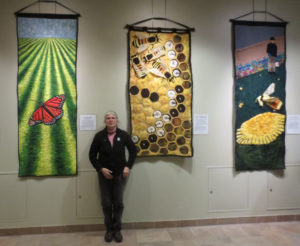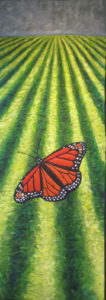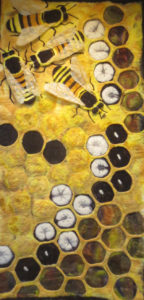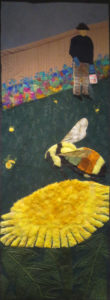Pollinators in Peril

Nancy at the Vermont Northeast Organic Farmers Association Conference in Feb 2015 next to the first three pieces of the Pollinators in Peril Series.
The Pollinators in Peril Project is a planned series of ten fiber and fabric pieces that present critical issues facing pollinators. The first three pieces were recently exhibited at the NOFA Conference on the University of Vermont Campus.
Pesticide exposure, habitat loss, pests and diseases are just a few of the stressors affecting native bees, honeybees, butterflies and other pollinator insects. About 30% of the food we eat requires insect pollinators, but about 90% of all plants do too. When we talk about pollinators in peril, we are really talking about humans in peril since pollinators are a critical player in the local and global ecology.
Why fiber and fabric art? When I thought about the best medium to bring attention to as well as honor our pollinators (the vast majority are female), I thought about quilting and fiber artists who are also mostly female. I also thought about the garment workers today and the women and girls who throughout history have sewed and stitched and spun and wove to clothe their family members and keep them warm with quilts and woolens. These art pieces bring honor and attention to their industrious work.
 Got Milkweed?
Got Milkweed?
(Acrylic media on muslin, machine quilted)
This piece depicts a lone female Monarch Butterfly on a fruitless search for milkweed on which to lay her eggs, in a sea of GMO corn. It is the story of how industrial monocropping agriculture in conjunction with Roundup-Ready™ GMO technology and government policy has resulted in the loss of food and habitat for pollinators. In this case, the loss has been milkweed, the sole source of food for the caterpillars of the Monarch butterfly. Milkweed flowers are also a great source of nectar for pollinators (honeybees, hundreds of native bees, butterflies and other insects). Allowing milkweed to grow up around your fields and property and not mowing it until late September when the Monarch caterpillars have all turned into butterflies is a great way to help this iconic pollinator.
 Know Your Beekeeper
Know Your Beekeeper
(Wet and needle felted wool)
Imported honey is suspected to contain sugar based additives and chemical or antibiotic contaminants. Know your beekeeper, know your honey. A great way to help the honeybees is to support your local beekeepers that are raising their bees using organic or natural methods and who are conscious of the native bees in their area. Honeybees (introduced into America back in the 1600s) can actually compete with native bees especially during the times when there may be a scarcity of nectar and pollen. Some beekeepers are planting extra floral resources for their bees.
All bees are under a lot of stress these days but honeybees have beekeepers that are looking out for their bees. Or at least they should be. Unfortunately, some commercial beekeeping has become another big agribusiness where bees are treated more like migratory micro machines to pollinate pesticide laced commodity crops like almonds, citrus, and apples, rather than the amazing social super organism that they are. Know your beekeeper, know your bees.
 Secret Toxic Garden – A Slow Quilt
Secret Toxic Garden – A Slow Quilt
(Made from vintage wool skirts and silk fabrics, nuno felted dandelion flower, needle felted bee, waste silk threads, acrylic medium on some bee parts, machine quilted, hand stitched)
This work depicts a faceless and clueless homeowner who thinks they are doing the right thing by spraying a broad spectrum neonicotinoid insecticide (neonics for short) to ‘protect’ their lawn. Bayer AG and Sygenta produce and sell millions of pounds of these insecticides, and they are keeping a deadly secret from the average homeowner and the general public. These are systemic insecticides that move throughout the plant’s tissues including the nectar and the pollen. They are highly toxic to bees and even minute amounts can cause sub-lethal effects to bumblebees, honeybees and native bees when they carry it back to their brood nests. Some of the documented effects are loss of navigational ability, death or stunting of larvae in the colony, and reduced immune functions. The European Union has outlawed or restricted neonics because of their impact on pollinators. Does your garden have a secret?
